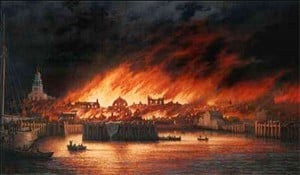
Main Street early in the morning on July 14. You look toward the Harbor and see nothing before you but smoking ashes and the brickwork of the Pacific Club Building. To the left, the Jared Coffin House is a lonely sentinel amid the ruin; to the right stands the badly scorched facade of the shops at the corner of Main and Orange.
One-hundred-and-sixty-seven years ago this week, the Great Fire of 1846 consumed one-third of Nantucket Town. This was the worst disaster in terms of material destruction that had ever hit the island, and it came at a time when Nantucket was very vulnerable to economic misfortune.
In 1846, Nantucket appeared to be a prosperous and cosmopolitan town. Decades of success in the whaling industry had brought wealth and sophistication to this small island. Nearly 10,000 people called Nantucket home; mansions built with whaling profits lined upper Main Street; 3 weekly newspapers were being published; and the center of town was a bustling commercial area. Between July of 1842 and July of 1845, more than 44,000 vessels passed through Nantucket Sound.
But by the mid-1840s whaling was in decline. The unbridled success of the previous decades had resulted in overfishing, and whaling men had to travel farther and stay out longer to fill their holds with oil. A sandbar across the mouth of Nantucket Harbor prevented the large, heavily-laden ships from entering, so many chose instead to depart from New Bedford’s deep port.
Fire had struck Nantucket several times before 1846: Brant Point Lighthouse had twice been destroyed by flames, the Fire of 1836 destroyed a hotel and several stores on Main Street, and, just four years before the Great Fire, the Quaise Poor Farm burned, killing 10 of its residents. Still the Town relied upon volunteer fire companies, hand-pumpers, and large underground cisterns of water for their defense.
The summer of 1846 was hot and very dry. When fire broke out around 11 p.m. on the night of July 13, two volunteer fire companies rushed to William Geary’s hat shop (near where the Lion’s Paw is now located). A fire had started in the rear of the shop in a stovepipe. Volunteers from two different fire companies arrived at the scene at about the same time—as they argued over who would put the fire out, the flames went through the roof and out of control.
The wooden structures of Main Street were quickly consumed as the blaze grew to frightening proportions, aided by the night winds. In an effort to stop the fire’s rapid progress, residents tried to create firebreaks by blowing up buildings with gunpowder. But nothing, it seemed, could stop the flames. The entire business district was ablaze. The air was filled with smoke, ash, heat, and the terrible sounds of bursting glass, crackling wood, and falling buildings.
By this time the streets were filled with desperate people. Some simply watched in horror, some tried to help combat the fire. Eyewitness William Macy stated: “standing on the steps of the Pacific Bank and looking east and north on Centre Street, east side as far as the Ocean House [now Jared Coffin House], every building was at one time on fire save the old insurance office building [the Pacific Club] on the lower square.”
Helped to spread by its own currents and updraft, the fire headed for the waterfront. Wooden wharves, ropewalks, cooperages, and storage houses, all soaked with oil, and caked with pitch and grease fed the inferno. Then it reached the casks of oil stored in the warehouses. As they burst with the heat, the oil spewed out across the surface of the harbor until even the water was burning.
By dawn the morning of July 14, 1846, the heart of Nantucket Town had been reduced to ashes. No one had perished in the Great Fire, but many hundreds were left homeless and destitute. The Atheneum with its books and exhibits had burned. Between 400 and 500 buildings on 36 acres had been destroyed; by conservative estimates, $1,000,000 in damage had been sustained.
Knowing that they would need aid to survive this disaster, the townspeople through the Selectmen sent out to the world an eloquent appeal:
“One-third of our town is in ashes. A fire broke out on Monday evening last…and raged almost uncontrolled, for about nine hours. The whole business section of the town is consumed. There is scarcely a dry goods, a grocery, or provision store left standing….There is not food enough in town to keep wide-spread suffering from hunger at bay a single week….Hundreds of families are without a roof to cover them, a bed to lie upon, and very many of them even without a change of raiment. Widows and old men have been stripped of their all; they have no hopes for the future, except such as are founded upon the humanity of others.
“We are in deep trouble….We need help–liberal and immediate. If we seem to you importunate, we can only say that could you look upon the yet smoking ruins of one third of our Town–could you walk through our remaining streets filled with houseless hundreds wandering about seeking for some roof to cover them, or for such remnants of their household goods as may have been snatched by others from the flames–could you feel, as we do, that not many days pass before positive want will be knocking at our doors–our words would appear feeble, our appeal certainly not more earnest than the occasion requires….”
Towns in America responded quickly with about $100,000 in assistance, and within a few months rebuilding began.



